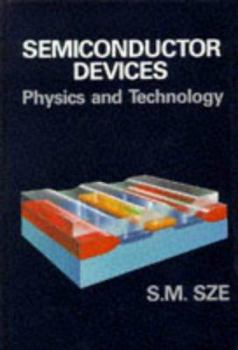Semiconductor Devices: Physics and Technology
Select Format
Select Condition 
Book Overview
A basic introduction to the physical properties of semiconductor devices and fabrication technology, this work presents the theoretical and practical aspects of every step in device fabrication, with an emphasis on integrated circuits. Divided into three parts, it covers the basic properties of semiconductors and processes, emphasizing silicon and gallium arsenide; the physics and characteristics of semiconductor devices, bipolar and unipolar devices, and special microwave and photonic devices; and the latest processing technologies, from crystal growth to lithographic pattern transfer.
Format:Hardcover
Language:English
ISBN:0471874248
ISBN13:9780471874249
Release Date:April 1985
Publisher:Wiley
Length:544 Pages
Weight:1.85 lbs.
Dimensions:1.1" x 6.6" x 9.6"
Customer Reviews
5 ratings
Nice Book from Dedicated Author
Published by Thriftbooks.com User , 18 years ago
The bible of semiconductor intended for under-/graduate students or as reference for advance scientist is the market of the author. The book consists of basic band gap explanation and carrier transport phenomena going through almost all exploited devices applied nowadays. Beside that, the technology starting form epitaxial growth until the etching mechanism is enclosed here. Moreover, the need of equation derivation is also appended herein since the author tries to explain them in deep. Some devices,e.g BARITT, TRAPATT are not explained here. The photonic device are coped in a concise clear way including the solar cell. The presentation and pictures attached here is well depicted and really helps the reader to the understanding of the material completely. Furthermore, this book is also well-suited for crash course for some experienced readers.
Excellent Basic Introduction for Engineers
Published by Thriftbooks.com User , 21 years ago
This is a welcome 2nd edition of Sze's basic introduction to the technology underlying modern conventional semiconductor devices. The first edition of 1985 served the needs of its time admirably, but the 17 years since have seen much progress in the field, especially in the area of fabrication technology.It should be stressed that this text is an introductory text, covering the basics well, but not taking the material much beyond the intermediate level. It is also very much an engineering text rather than a physics text, for the focus is squarely placed on the technology and not the underlying solid-state physics. As such, it is suited to undergraduate electrical/electronic engineers wishing to gain some appreciation of the physics underpinning conventional semiconductor devices, and the way they are fabricated, or for physicists wishing to gain some perspective on the fabrication and operation of the same, but it is in no way a comprehensive textbook on semiconductor physics.Nevertheless, the material that is presented is well chosen, and well explained. The English prose style is somewhat pedestrian, but this is no great flaw in an engineering textbook. All the essentials of semiconductor materials (almost exclusively Si and GaAs) are described, the p-n junction, as well as the major device types (BJTs, (MOS/MES)FETs, microwave diodes, LEDs, lasers, etc.) and the modern technologies employed for their fabrication. In some senses, the section on fabrication technologies, taking up fully a third of the book, is perhaps its best section, for fabrication is rarely given such emphasis (although, again, not detailed, but covering most salient points) in an introductory book.The pedagogical method employed by Sze is sound, and relevant worked examples are provided. The only short-coming is perhaps the relative brevity of the end-of-chapter problems, for which no answers are provided, but, in such a textbook, I feel that it is not really necessary to work through them to gain a solid grasp of the material presented.Physically, the book is much more attractive than the previous edition. The cover is more appealling, and the text is well set in a two-colour print. The diagrams are nothing special, but they are generally clear and explain their point well, and are certainly much improved from the first edition, especially those in the fabrication section.Just a final comment on other reviews: it is difficult to see how this book may be regarded as a bible of any sort, for the material is covered in quite a superficial manner. I wonder if they are not mistaking it for the 'big Sze', viz., Sze's 'Physics of Semiconductor Devices', which is another, much larger and more comprehensive, work of Sze's.
Recommended as a reference book
Published by Thriftbooks.com User , 23 years ago
This is a good book providing the most important references in the field of semiconductors devices and technology. As a text book it is hard to follow and gives little scientific background regarding the physics of processes in semiconductors and structures design criteria. However, it provides a wonderful summary of the most important facts related to the devices and their derivatives, including valuable data on the common materials in use.
Good, but not excellent book!
Published by Thriftbooks.com User , 23 years ago
This is a very famous book for describing the semiconductor physics, although this is not new. Some people maybe think that is hard to follow, but it does provide a lot of information and document for readers. Thus, it can be a very good reference book because it introduces many important papers in semiconductor developments. So you will know why and how semiconductor devices become what we see today!
The book I use every day
Published by Thriftbooks.com User , 24 years ago
Explains the basic concepts in device physics well. Covers generic process steps used to make most semiconductors. Probably a bit outdated, though physics hasn't changed much since 1985. This book is referred to as "eazy Sze" around my office, which is a refrence to "hard Sze"--The physics of semiconductor devices, 1981. "Hard Sze" is the ultimate refrence for device physics.






